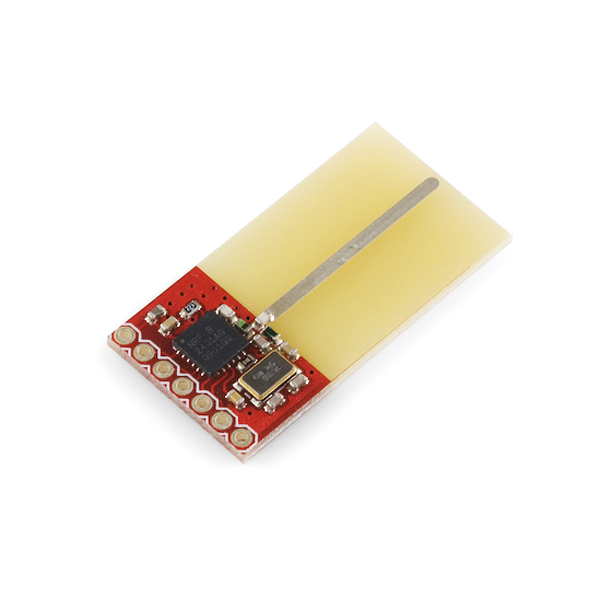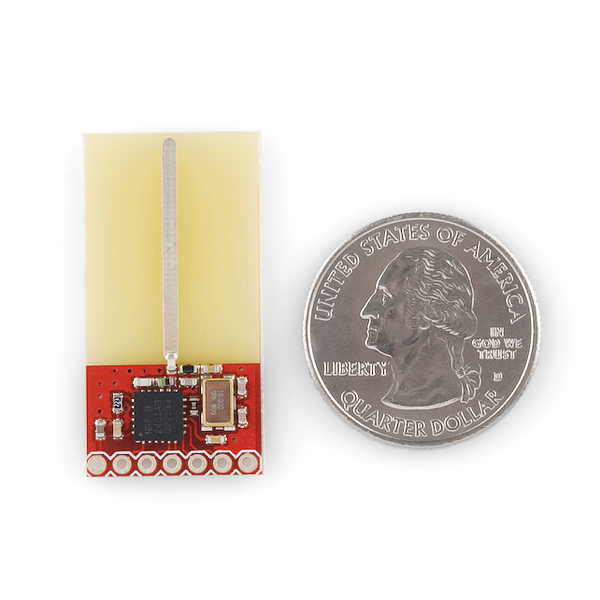SparkFun Trace Antenna Transceiver - nRF2401A
Miniature RF (MiRF) 2.4GHz transceiver modules with built in antenna designed around the Nordic Semiconductor nRF2401A with high sensitivity and good range. These units are a SparkFun exclusive; small in stature, big on performance, all wrapped up in a user friendly package. Units come with an empty 0.1" spaced footprint ready for a straight header, right angle header (recommended), or your own wires/umbilical cable.
Note: These are sold as single units. We recommend ordering two for a complete link.
Specifications:
- Frequency: 2.4~2.524 GHz
- Modulation type: GFSK
- Operating Voltage: 3V
- Output Power: +0dBm
- Data Rate: 1Mbps; 250Kbps
- Small footprint size: 0.7x1.3" (18x33mm)
- Operating Temperature: -40 ~ +85 C
- Long range:
- 50ft. indoors
- 125ft. line-of-sight
- Built-in antenna
- Broken out pins:
- 3.3V VCC / GND
- CE : Chip Enable
- CS : Chip Select
- DR1 : Data Ready
- CLK1 : Clock
- DATA : Data
- Schematic
- Eagle Files
- Datasheet (nRF2401A)
- Example Code
- Range Test
- GitHub
SparkFun Trace Antenna Transceiver - nRF2401A Product Help and Resources
Core Skill: Soldering
This skill defines how difficult the soldering is on a particular product. It might be a couple simple solder joints, or require special reflow tools.
Skill Level: Noob - Some basic soldering is required, but it is limited to a just a few pins, basic through-hole soldering, and couple (if any) polarized components. A basic soldering iron is all you should need.
See all skill levels
Core Skill: Programming
If a board needs code or communicates somehow, you're going to need to know how to program or interface with it. The programming skill is all about communication and code.
Skill Level: Rookie - You will need a better fundamental understand of what code is, and how it works. You will be using beginner-level software and development tools like Arduino. You will be dealing directly with code, but numerous examples and libraries are available. Sensors or shields will communicate with serial or TTL.
See all skill levels
Core Skill: Electrical Prototyping
If it requires power, you need to know how much, what all the pins do, and how to hook it up. You may need to reference datasheets, schematics, and know the ins and outs of electronics.
Skill Level: Rookie - You may be required to know a bit more about the component, such as orientation, or how to hook it up, in addition to power requirements. You will need to understand polarized components.
See all skill levels
Comments
Looking for answers to technical questions?
We welcome your comments and suggestions below. However, if you are looking for solutions to technical questions please see our Technical Assistance page.
Customer Reviews
No reviews yet.





This module would be awesome with an SMA connector, wouldn't it? This antenna looks too uncomfortable to put around in a case under the rain, and the other module with the on-chip antenna looks like having problems with range.
0dBm is 1mW, right?
Yep. You can use this conversion table.
Is it possible to transmit data from a uC to PC and vice versa if on the controller side I use a nRF2401A and on the PC I use a WRL-09019 with nRF24L01 on it ?
Thank you.
Has anyone ever gotten this to work with arduino successfully ? I tried using the library available for NRF2401 on their website but it doesn�t work.
Make sure you set your baud rate, worked for us. No guarantees tho...
how much do these weigh?
Last batch use the nFR24AP1 not the nFR2401A chip. It seems protocol are not the same I think.